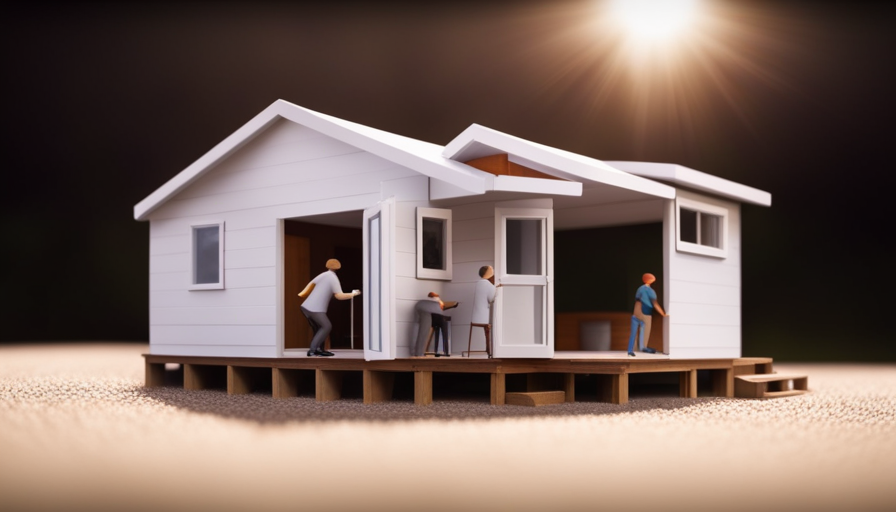In the vast desert landscape of Nevada, among the endless possibilities that seem to stretch on forever, there lies a hidden treasure: the tiny house. This symbol of freedom, minimalism, and environmental consciousness has captivated many seeking a unique way of life, winning over their hearts and inspiring their creativity.
But in this land of boundless potential, how big can a tiny house truly be?
Nevada’s regulations and zoning laws for tiny houses may seem like a labyrinth of restrictions and guidelines, but fear not, for I shall be your guide through this intricate maze. Together, we will navigate the intricate web of rules, determine the maximum square footage allowed, explore innovative design solutions, and discover suitable locations and communities for tiny house living.
So, join me on this remarkable journey as we delve into the depths of Nevada’s tiny house landscape, uncovering the practical considerations, permitting processes, and the myriad of benefits that come with living big in a tiny house. It’s time to unlock the door to a world where size truly doesn’t matter.
Key Takeaways
- The minimum square footage for a tiny house on a foundation in Nevada is typically around 200 square feet.
- The maximum square footage allowed for a tiny house on wheels in Nevada is typically around 400 square feet, but it can vary depending on local regulations.
- Some regions in Nevada have adopted the International Residential Code (IRC) Appendix Q, which provides guidelines for tiny houses on a foundation.
- Zoning restrictions and local regulations should be considered when building or living in a tiny house in Nevada.
Understanding Nevada’s Regulations and Zoning Laws for Tiny Houses
If you’re considering building a tiny house in Nevada, it’s important to understand the state’s regulations and zoning laws.
When it comes to determining the minimum square footage for a tiny house, there are specific guidelines to follow. In Nevada, the minimum square footage requirement for a tiny house on a foundation is typically around 200 square feet. However, it’s crucial to check with the local zoning department as requirements may vary depending on the specific county or municipality.
Understanding zoning restrictions is also essential when planning to build a tiny house in Nevada. Some areas may have restrictions on where tiny houses can be located, such as limiting them to certain zones or requiring them to be part of an existing dwelling. These regulations are in place to ensure safety and maintain the character of the community.
Now, let’s move on to determining the maximum square footage allowed for a tiny house in Nevada.
Determining the Maximum Square Footage Allowed for a Tiny House in Nevada
You can find out the maximum square footage allowed for a cozy home on wheels in the beautiful state of Nevada. Here are three key points to consider regarding the maximum square footage and zoning laws for tiny houses in Nevada:
-
Zoning laws vary across different regions in Nevada, so it’s important to research and understand the specific regulations in the area where you plan to place your tiny house.
-
In some areas, the maximum square footage allowed for a tiny house on wheels is typically around 400 square feet. However, this may vary depending on the local zoning laws and regulations.
-
Some regions in Nevada have adopted the International Residential Code (IRC) Appendix Q, which provides specific guidelines for tiny houses on a foundation. These guidelines often include a maximum square footage limit that ranges from 400 to 800 square feet.
By understanding the maximum square footage allowed and the specific zoning laws in Nevada, you can ensure that your tiny house complies with regulations.
Transitioning into the subsequent section, let’s now explore creative design solutions to maximize space in a tiny house.
Exploring Creative Design Solutions to Maximize Space in a Tiny House
To make the most of limited space in a small dwelling, consider incorporating multi-purpose furniture, such as a sofa that can transform into a bed, like the one used by Jane in her 300-square-foot urban apartment in Reno. Maximizing functionality is crucial when designing a tiny house, and utilizing furniture that serves dual purposes is an effective way to achieve this.
In addition to multi-purpose furniture, optimizing storage is essential in a tiny house. Utilize vertical space by installing shelves or cabinets that reach up to the ceiling. Consider utilizing under-bed storage or incorporating built-in storage solutions. Every inch counts in a tiny house, so it’s important to carefully plan and utilize the available space efficiently.
By maximizing functionality and optimizing storage, you can create a comfortable and efficient living environment in a tiny house. Transitioning into considering practical considerations for living in a tiny house in Nevada, it is important to also consider factors such as energy efficiency and zoning regulations.
Considering Practical Considerations for Living in a Tiny House in Nevada
When considering the practical aspects of living in a small dwelling in the Silver State, it’s important to take into account energy efficiency and local zoning regulations.
In Nevada, where temperatures can soar in the summer and drop in the winter, energy efficiency becomes crucial to ensure comfortable living conditions year-round. To achieve this, consider using insulation with high R-values, energy-efficient appliances, and renewable energy sources such as solar panels.
Additionally, familiarize yourself with the local zoning regulations to ensure your tiny house meets the required standards and can be legally parked or placed on a specific piece of land. Some alternative housing options in Nevada include tiny house communities, RV parks, and private land rentals. These options provide a sense of community and amenities that enhance the tiny house living experience.
Transitioning to finding suitable locations and communities for tiny house living in Nevada, it is essential to explore different areas that align with your lifestyle and preferences.
Finding Suitable Locations and Communities for Tiny House Living in Nevada
Explore the unique communities and scenic landscapes of the Silver State, where your dream of living in a small, sustainable dwelling can become a reality. Nevada offers a variety of tiny house communities that cater to individuals seeking a minimalist lifestyle. These communities provide an opportunity to connect with like-minded individuals and enjoy shared amenities such as communal gardens and gathering spaces.
Additionally, for those seeking a more secluded experience, there are numerous off-grid locations available throughout the state. These remote areas allow tiny house enthusiasts to embrace a self-sufficient lifestyle, relying on renewable energy sources and practicing sustainable living.
Discovering the perfect location for your tiny house in Nevada is just the first step towards fulfilling your dream. Next, we will explore the process of navigating the permitting process for building a tiny house in Nevada.
Navigating the Permitting Process for Building a Tiny House in Nevada
Embarking on the journey of building your dream sustainable dwelling in Nevada involves navigating a complex permitting process. You’ll need to traverse through the intricate maze of regulations and guidelines. Here are four key permitting challenges you may encounter when building a tiny house in Nevada:
-
Zoning restrictions: Ensure that the location you choose allows for tiny houses and complies with the local zoning regulations. Some areas may have specific requirements for minimum lot size or setbacks.
-
Building code requirements: Familiarize yourself with the building codes applicable to tiny houses in Nevada. These codes may include regulations on minimum room sizes, ceiling heights, and safety features such as smoke detectors and fire escapes.
-
Utility connections: Determine how you will connect your tiny house to utilities such as water, electricity, and sewage. Some areas may require specific permits or inspections for these connections.
-
Permitting timeline: Be prepared for potential delays in the permitting process. It’s important to understand the timeline and requirements for each permit you need to obtain.
Navigating the permitting process can be challenging, but it’s a necessary step towards realizing your dream of living big in a tiny house in Nevada.
Transitioning to the subsequent section about embracing the benefits of this lifestyle, let’s explore the possibilities of maximizing space and minimizing environmental impact.
Embracing the Benefits of Living Big in a Tiny House in Nevada
Now that we’ve discussed the ins and outs of navigating the permitting process for building a tiny house in Nevada, let’s shift our focus to embracing the benefits of living big in a tiny house in this state.
Living large doesn’t always mean having a big house; it’s about making the most of the space you have. Downsizing has numerous benefits, both practical and financial. By embracing a minimalist lifestyle, you can reduce your carbon footprint, minimize your expenses, and simplify your daily routine.
With careful planning and smart design choices, you can maximize the functionality and efficiency of your tiny house, creating a comfortable and spacious living environment.
Nevada offers a unique opportunity to experience the joys of living large in a tiny house, so let’s dive into the details and explore the endless possibilities that await those who choose to downsize.
Frequently Asked Questions
What are the specific regulations and zoning laws for tiny houses in Nevada?
Specific regulations and zoning laws for tiny houses in Nevada are governed by local jurisdictions, so it’s important to research the specific area you plan to build in.
Building codes will dictate the size, materials, and safety requirements for your tiny house.
Zoning laws determine where you can place your tiny house, whether it’s in a tiny house community or on your own land.
Financing options, land availability, off-grid living, environmental impact, building permits, and insurance requirements are all factors to consider when embarking on your tiny house journey in Nevada.
How is the maximum square footage allowed for a tiny house determined in Nevada?
Determining the maximum square footage allowed for a tiny house in Nevada is guided by Nevada regulations and zoning laws. Design solutions that focus on space maximization can help meet the requirements. Practical considerations, such as the number of occupants and necessary amenities, also play a role.
Living in a tiny house requires suitable locations, which may include designated tiny house communities. Compliance with local regulations is essential to ensure adherence to the maximum square footage allowed.
What are some creative design solutions to maximize space in a tiny house?
When it comes to maximizing space in a tiny house, innovative storage solutions and multi-functional furniture are key.
One creative design solution is to utilize vertical space by installing floor-to-ceiling shelving or utilizing wall-mounted storage units.
Additionally, incorporating furniture with built-in storage compartments or convertible features can help maximize space.
By thinking outside the box and utilizing these design strategies, you can make the most of every square inch in your tiny house.
What practical considerations should be taken into account when living in a tiny house in Nevada?
Practical considerations should be taken into account when living in a tiny house in Nevada. Some benefits include reduced expenses, minimal maintenance, and a smaller carbon footprint. However, challenges such as limited storage space, potential zoning restrictions, and extreme weather conditions should be addressed.
It’s crucial to plan for efficient use of space, install proper insulation, and design a functional layout. Additionally, water and power sources, as well as waste management, should be carefully considered.
How can one find suitable locations and communities for tiny house living in Nevada?
When it comes to finding suitable locations and communities for tiny house living in Nevada, there are a few factors to consider.
One option is to join online forums and social media groups dedicated to tiny house enthusiasts, where you can connect with like-minded individuals and get recommendations.
Additionally, there are websites specifically designed to help you locate tiny house communities in Nevada.
As for financing options, some lenders offer specialized loans for tiny homes, while others may consider it as a personal loan.
Conclusion
In conclusion, living big in a tiny house in Nevada isn’t just possible, but it also offers a unique and fulfilling lifestyle. By understanding the state’s regulations and zoning laws, determining the maximum square footage allowed, exploring creative design solutions, and considering practical considerations, one can successfully build and enjoy a tiny house in Nevada.
Additionally, finding suitable locations and communities and navigating the permitting process are crucial steps in the process. It’s important to remember that "good things come in small packages," and embracing the benefits of tiny house living can bring joy, simplicity, and a sense of freedom to one’s life.
Hi, I’m Emma. I’m the Editor in Chief of Tiny House 43, a blog all about tiny houses. While tree houses are often associated with childhood, they can be the perfect adult retreat. They offer a cozy space to relax and unwind, surrounded by nature. And since they’re typically built on stilts or raised platforms, they offer stunning views that traditional homes simply can’t match. If you’re looking for a unique and romantic getaway, a tree house tiny house might just be the perfect option.
















